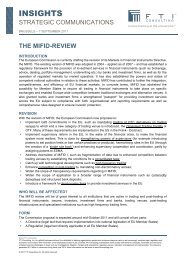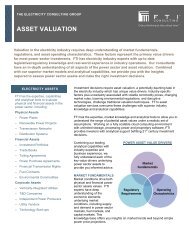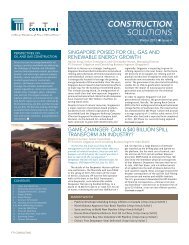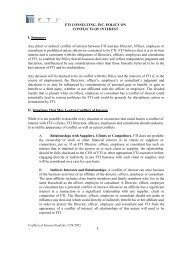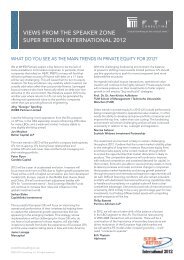(including, but not limited to, borrowing capacity under our amended and restated senior secured bank creditfacility or the availability of alternative financing), may cause us to be unable to pursue or complete anacquisition. Our ability to grow our business, particularly through acquisitions, may depend on our ability to raisecapital by selling equity or debt securities or obtaining additional debt financing. There can be no assurance thatwe will be able to obtain financing when we need it or on terms acceptable to us. As a result of these factors, wemay be unable to grow our business or expand our client offerings as quickly as we have in the past or as wecurrently plan.We may have difficulty integrating our acquisitions or convincing clients to allow assignment of theirengagements to us, which can reduce the benefits we receive from acquisitions.A substantial amount of our growth has resulted from acquisitions. The process of managing and integratingour acquisitions into our existing operations may result in unforeseen operating difficulties and may requiresignificant financial, operational and managerial resources that would otherwise be available for the operation,development and expansion of our existing business. To the extent that we misjudge our ability to integrate andproperly manage acquisitions, we may have difficulty achieving our operating, strategic and financial objectives.Acquisitions also may involve a number of special financial, business and operational risks, such as:• difficulties in integrating diverse corporate cultures and management styles;• disparate company policies and practices;• client relationship issues;• decreased utilization during the integration process;• loss of key existing or acquired personnel;• increased costs to improve or coordinate managerial, operational, financial and administrative systems;• dilutive issuances of equity securities, including convertible debt securities to finance acquisitions;• the assumption of legal liabilities;• amortization of acquired intangible assets;• future earn-out payments or other price adjustments; and• potential write-offs relating to the impairment of goodwill.In addition to the integration challenges mentioned above, our acquisitions of non-U.S. companies offerdistinct integration challenges relating to non-U.S. GAAP financial reporting, foreign laws and governmentalregulations, including tax and employee benefit laws, and other factors relating to operating in countries otherthan the U.S., which have been discussed above in the discussion regarding the difficulties we may faceoperating globally.Asset transactions may require us to seek client consents to the assignment of their engagements to us or asubsidiary. All clients may not consent to an assignment. In certain cases, such as government contracts andbankruptcy engagements, the consents of clients cannot be solicited until after the acquisition has closed. Further,such engagements may be subject to security clearance requirements or bidding provisions with which we mightnot be able to comply. There is no assurance that local, state, federal or foreign governments will agree to novatetheir contracts to us.Strategic acquisitions in the Technology segment may not be accretive in the near term.To compete for strategic acquisitions that complement our Technology segment, competitive marketconditions may require us to pay prices that represent a higher multiple of revenues or profits than acquisitions30
we make in other business sectors. Because technology companies often are high-growth businesses, theytypically can command higher purchase price multiples. As a result of these competitive dynamics, certainacquisitions with strategic importance to the future growth and profitability of our Technology segment may notbe accretive to our overall financial results in the near term.We may have a different system of governance and management from the companies we acquire or theirparents, which could cause professionals who join us from acquired companies to leave us.Our governance and management practices and policies do not mirror the policies and practices of acquiredcompanies or their parents. In some cases, different management practices and policies may lead to workplacedissatisfaction on the part of acquired professionals. Some professionals may choose not to join our company orleave after joining us. Existing professionals may leave us as well. The loss of key professionals may harm ourbusiness and results of operations and cause us not to realize the anticipated benefits of the acquisition.Due to fluctuations in our stock price, acquisition candidates may be reluctant to accept shares of ourcommon stock as purchase price consideration , use of our shares as purchase price consideration may bemore dilutive, and the owners of certain companies we seek to acquire may insist on stock price guarantees.We structure many acquisitions to pay a portion of the purchase price in shares of our common stock. Thenumber of shares issued as consideration is typically based on an average closing price per share of our commonstock for a number of days prior to the closing of such acquisition. We believe that payment in the form of <strong>FTI</strong>shares of common stock provides the acquired entity and its principals with a vested interest in the future successof the acquisition and <strong>FTI</strong>. The recent extreme volatility of stock markets and the recent decline and volatility ofthe price per share of <strong>FTI</strong> common stock may result in acquisition candidates being reluctant to accept our sharesas consideration. In such cases, we may have to issue more shares, if stock constitutes part of the consideration,pay the entire purchase price in cash, or negotiate an alternative price structure. The result may be an increase inthe cost of an acquisition.Certain acquisition related agreements contain stock price guarantees that may result in cash payments inthe future if our price per share falls below a specified per share market value on the date restrictions lapse.Acquisition candidates may continue to negotiate stock price guarantees, particularly in light of our recent stockprice volatility, which may increase the cash paid for an acquisition.Risks Related to Our IndebtednessOur substantial indebtedness could adversely affect our financial condition and business operations.We have a significant amount of indebtedness. As of December 31, <strong>2009</strong>, the principal amount of ouroutstanding borrowings totaled $566.1 million of which $564.9 million is under our 7 5 ⁄8% senior notes due 2013,3 3 ⁄4% senior subordinated convertible notes due 2012 and 7 3 ⁄4% senior notes due 2016 (collectively, our notes)and $3.8 million of outstanding letters of credit under our senior secured bank revolving credit facility. We havean additional $171.2 million of revolving credit available under our senior secured bank credit facility.Our substantial indebtedness could have important consequences. For example, it could:• make it more difficult to satisfy our other financial obligations;• increase our vulnerability to adverse economic and industry conditions;• require us to dedicate a substantial portion of our cash flows from operations to payments on ourindebtedness, thereby reducing the availability of our cash flows to fund working capital, capitalexpenditures, research and development efforts and other general corporate purposes;• limit our ability to borrow additional funds; or• limit our ability to make future acquisitions.31
- Page 2 and 3: 2009 was a year in which the world
- Page 5: the e-discovery market led us to cr
- Page 12 and 13: Equity Sponsor Services. Equity spo
- Page 14 and 15: Discovery Assistance. We help to dr
- Page 16 and 17: identification of relevant content
- Page 18: distinguishes us from other strateg
- Page 21 and 22: Department of Justice and Treasury
- Page 23 and 24: • Premium Brand Names with Leadin
- Page 25 and 26: Employment AgreementsAs of December
- Page 27 and 28: We have a staff of seven marketing
- Page 29 and 30: Corporate InformationFTI Consulting
- Page 31 and 32: Our segments may face risks of fee
- Page 33 and 34: could adversely affect our Strategi
- Page 35 and 36: and experience necessary to manage
- Page 37: In reaction to publicized incidents
- Page 41 and 42: Our indebtedness is guaranteed by s
- Page 43 and 44: Equity Compensation Plan Informatio
- Page 45 and 46: Share based payments to employees a
- Page 47 and 48: ITEM 7. MANAGEMENT’S DISCUSSION A
- Page 49 and 50: corporate expenses include primaril
- Page 51 and 52: clients. Margins for the year decli
- Page 53 and 54: • a significant change in the man
- Page 55 and 56: Additionally, we record deferred ta
- Page 57 and 58: Year Ended December 31, 2009 compar
- Page 59 and 60: Other Segment Operating DataYear En
- Page 61 and 62: 14.6% in 2008. The increase in SG&A
- Page 63 and 64: expense in 2009 was primarily due t
- Page 65 and 66: Amortization of other intangible as
- Page 67 and 68: Gross profit margins increased by 6
- Page 69 and 70: foreign currency translation of app
- Page 71 and 72: The availability of borrowings unde
- Page 73 and 74: Future Contractual ObligationsThe f
- Page 75 and 76: Equity Price SensitivityWe currentl
- Page 77 and 78: Management’s Report on Internal C
- Page 79 and 80: Report of Independent Registered Pu
- Page 81 and 82: FTI Consulting, Inc. and Subsidiari
- Page 83 and 84: FTI Consulting, Inc. and Subsidiari
- Page 85 and 86: FTI Consulting, Inc. and Subsidiari
- Page 87 and 88: FTI Consulting, Inc. and Subsidiari
- Page 89 and 90:
FTI Consulting, Inc. and Subsidiari
- Page 91 and 92:
FTI Consulting, Inc. and Subsidiari
- Page 93 and 94:
FTI Consulting, Inc. and Subsidiari
- Page 95 and 96:
FTI Consulting, Inc. and Subsidiari
- Page 97 and 98:
FTI Consulting, Inc. and Subsidiari
- Page 100 and 101:
FTI Consulting, Inc. and Subsidiari
- Page 102 and 103:
FTI Consulting, Inc. and Subsidiari
- Page 104 and 105:
FTI Consulting, Inc. and Subsidiari
- Page 106 and 107:
FTI Consulting, Inc. and Subsidiari
- Page 108 and 109:
FTI Consulting, Inc. and Subsidiari
- Page 110 and 111:
FTI Consulting, Inc. and Subsidiari
- Page 112 and 113:
FTI Consulting, Inc. and Subsidiari
- Page 114 and 115:
FTI Consulting, Inc. and Subsidiari
- Page 116 and 117:
FTI Consulting, Inc. and Subsidiari
- Page 118 and 119:
FTI Consulting, Inc. and Subsidiari
- Page 120 and 121:
FTI Consulting, Inc. and Subsidiari
- Page 122 and 123:
FTI Consulting, Inc. and Subsidiari
- Page 124 and 125:
FTI Consulting, Inc. and Subsidiari
- Page 126 and 127:
ITEM 9. CHANGES IN AND DISAGREEMENT
- Page 128 and 129:
PART IVITEM 15. EXHIBITS AND FINANC
- Page 130 and 131:
ExhibitNumber Description of Exhibi
- Page 132 and 133:
ExhibitNumber Description of Exhibi
- Page 134 and 135:
ExhibitNumber Description of Exhibi
- Page 136 and 137:
ExhibitNumber Description of Exhibi
- Page 138 and 139:
ExhibitNumber Description of Exhibi
- Page 140 and 141:
ExhibitNumber Description of Exhibi
- Page 142 and 143:
ExhibitNumber Description of Exhibi
- Page 144 and 145:
ExhibitNumber Description of Exhibi
- Page 146 and 147:
ExhibitNumber Description of Exhibi
- Page 148 and 149:
SIGNATURESPursuant to the requireme
- Page 150 and 151:
FTI Consulting Canada LLC .........
- Page 152 and 153:
The Board of DirectorsFTI Consultin
- Page 154 and 155:
Exhibit 31.2Certification of Princi
- Page 156 and 157:
Exhibit 32.2Certification of Princi
- Page 158 and 159:
CORPORATE TEAMJack B. Dunn, IVPresi



